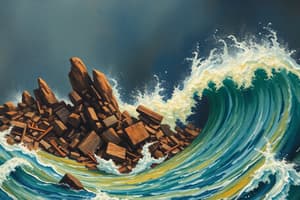Podcast
Questions and Answers
What is the main cause of most tsunamis?
What is the main cause of most tsunamis?
- Landslides
- Earthquakes (correct)
- Glaciers breaking off
- Volcanic eruptions
How are tsunamis described in terms of their waves?
How are tsunamis described in terms of their waves?
- Huge and mighty (correct)
- Small and gentle
- Loud and powerful
- Slow and calming
What happens when tectonic plates get stuck according to the passage?
What happens when tectonic plates get stuck according to the passage?
- They lose their structure
- They shrink in size
- They start rotating
- They create big holes on the ocean floor (correct)
How fast can tsunami waves travel as per the text?
How fast can tsunami waves travel as per the text?
What happens to the height of a tsunami wave when it reaches shallower water?
What happens to the height of a tsunami wave when it reaches shallower water?
Apart from earthquakes, what other natural disaster can cause tsunamis?
Apart from earthquakes, what other natural disaster can cause tsunamis?
What is a characteristic of tsunamis mentioned in the text?
What is a characteristic of tsunamis mentioned in the text?
Where is the Pacific Tsunami Warning System based?
Where is the Pacific Tsunami Warning System based?
Which country experienced the biggest tsunami ever recorded?
Which country experienced the biggest tsunami ever recorded?
How often do tsunamis usually occur according to the text?
How often do tsunamis usually occur according to the text?
What purpose does the Pacific Tsunami Warning System serve?
What purpose does the Pacific Tsunami Warning System serve?
Which of the following statements is true according to the text?
Which of the following statements is true according to the text?
Flashcards are hidden until you start studying
Study Notes
Tsunami Causes and Characteristics
- Most tsunamis are primarily caused by underwater earthquakes, particularly those occurring along tectonic plate boundaries.
- Tsunami waves are described as long-wavelength waves that can travel across entire ocean basins with great speed.
Tectonic Plate Dynamics
- When tectonic plates get stuck, stress accumulates over time until it is released suddenly as an earthquake, potentially triggering a tsunami.
Wave Speed and Behavior
- Tsunami waves can travel at speeds up to 500-600 miles per hour (about 800-965 kilometers per hour) in deep water.
- As tsunami waves approach shallower water, their height increases dramatically due to the conservation of energy, leading to potentially devastating coastal impacts.
Other Tsunami Triggers
- Besides earthquakes, volcanic eruptions and underwater landslides can also generate tsunamis.
Tsunami Characteristics
- A key characteristic of tsunamis is their ability to generate a series of waves, often leading to multiple surges that can impact coastlines in quick succession.
Pacific Tsunami Warning System
- The Pacific Tsunami Warning System is based in Hawaii and is responsible for monitoring seismic activity and issuing warnings for potential tsunami threats.
- Its primary purpose is to alert regions at risk of tsunamis, helping to ensure public safety.
Historic Tsunami Events
- The country that experienced the largest tsunami ever recorded is Japan, particularly noted for the 2011 Tōhoku earthquake and tsunami.
Occurrence Frequency
- Tsunamis typically occur multiple times a year around the world, but most are small and go unnoticed.
Key Statement Validation
- Understanding specific statements regarding tsunamis and their characteristics is crucial for comprehensive knowledge of this natural phenomenon.
Studying That Suits You
Use AI to generate personalized quizzes and flashcards to suit your learning preferences.




